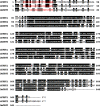Preparation of Tyrosylprotein Sulfotransferases for In Vitro One-Pot Enzymatic Synthesis of Sulfated Proteins/Peptides
- PMID: 30320268
- PMCID: PMC6173500
- DOI: 10.1021/acsomega.7b01533
Preparation of Tyrosylprotein Sulfotransferases for In Vitro One-Pot Enzymatic Synthesis of Sulfated Proteins/Peptides
Abstract
Protein tyrosine sulfation (PTS), catalyzed by membrane-anchored tyrosylprotein sulfotransferase (TPST), is one of the most common post-translational modifications of secretory and transmembrane proteins. PTS, a key modulator of extracellular protein-protein interactions, accounts for various important biological activities, namely, virus entry, inflammation, coagulation, and sterility. The preparation and characterization of TPST is fundamental for understanding the synthesis of tyrosine-sulfated proteins and for studying PTS in biology. A sulfated protein was prepared using a TPST-coupled protein sulfation system that involves the generation of the active sulfate 3'-phosphoadenosine-5'-phosphosulfate (PAPS) through either PAPS synthetase (PAPSS) or phenol sulfotransferase. The preparation of sulfated proteins was confirmed through radiometric or immunochemical assays. In this study, enzymatically active Drosophila melanogaster TPST (DmTPST) and human TPSTs (hTPST1 and hTPST2) were expressed in Escherichia coli BL21(DE3) host cells and purified to homogeneity in high yield. Our results revealed that recombinant DmTPST was particularly useful considering its catalytic efficiency and ease of preparation in large quantities. This study provides tools for high-efficiency, one-step synthesis of sulfated proteins and peptides that are useful for further deciphering the mechanisms, functions, and future applications of PTS.
Conflict of interest statement
The authors declare no competing financial interest.
Figures







Similar articles
-
High-Throughput Screening of Sulfated Proteins by Using a Genome-Wide Proteome Microarray and Protein Tyrosine Sulfation System.Anal Chem. 2017 Mar 21;89(6):3278-3284. doi: 10.1021/acs.analchem.6b02853. Epub 2017 Mar 2. Anal Chem. 2017. PMID: 28211678
-
New tools for evaluating protein tyrosine sulfation: tyrosylprotein sulfotransferases (TPSTs) are novel targets for RAF protein kinase inhibitors.Biochem J. 2018 Aug 14;475(15):2435-2455. doi: 10.1042/BCJ20180266. Biochem J. 2018. PMID: 29934490 Free PMC article.
-
Post-translational modification of protein by tyrosine sulfation: active sulfate PAPS is the essential substrate for this modification.Nucleic Acids Symp Ser. 1992;(27):183-4. Nucleic Acids Symp Ser. 1992. PMID: 1289811
-
Tyrosine sulfation as a protein post-translational modification.Molecules. 2015 Jan 28;20(2):2138-64. doi: 10.3390/molecules20022138. Molecules. 2015. PMID: 25635379 Free PMC article. Review.
-
3'-Phosphoadenosine 5'-phosphosulfate biosynthesis and the sulfation of cholecystokinin by the tyrosylprotein-sulfotransferase in rat brain tissue.Chem Biol Interact. 1994 Jun;92(1-3):281-91. doi: 10.1016/0009-2797(94)90070-1. Chem Biol Interact. 1994. PMID: 8033261 Review.
Cited by
-
Silicon Nanowire Field-Effect Transistor as Biosensing Platforms for Post-Translational Modification.Biosensors (Basel). 2020 Dec 21;10(12):213. doi: 10.3390/bios10120213. Biosensors (Basel). 2020. PMID: 33371301 Free PMC article.
References
LinkOut - more resources
Full Text Sources
Molecular Biology Databases

